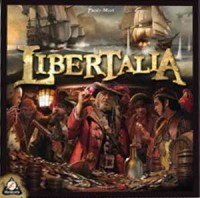
Libertalia
Overview
Libertalia is a competitive card game that pits rival pirate bands against each other to see who can loot, pillage and plunder the most booty in three 6-day campaigns. Players must out-think their opponents using archetypal pirate character cards that each has a unique game effect. Players whose pirates gather the most doubloons after 3 campaigns can retire on their pirate paradise named “Libertalia.”
Gameplay
The unique mechanics of Libertalia start to reveal themselves during the set-up of the game. This requires a brief explanation of the decks of cards that are used.
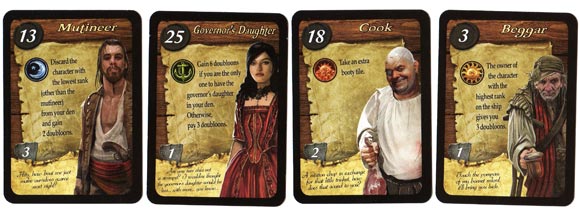
Libertalia is not a deck-builder. Each player has – in their own piratical player color – a deck of 30 identical character cards. They are numbered from 1 to 30 and each depicts a pirate themed character advancing in rank from low to high. The ship’s mascot: the Parrot is card number 1, while the Spanish Governor is card number 30. At the beginning of the first campaign, the youngest player shuffles and draws a hand of 9 cards. That player then calls out the name and rank of each card as each other player removes those exact named cards from their decks to form their starting hands. Consequently, each player has the same crew and same game effects going into the first campaign.
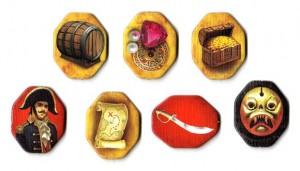
Libertalia is played in a series of three Campaigns. Each Campaign is made up of six days of looting and pillaging and grabbing the best booty available. Ok, ok, that’s Pirate booty. I mean, it’s booty that the pirates want… ugh, never mind.
One day, consists of four phases that follows the cycle of the sun: beginning with Sunrise, Day, followed by Dusk and finally Night. There is also a Campaign Phase after all pirates have returned after six days of exploits.
At sunrise, all players secretly choose one character from their hand of nine and simultaneously reveal it. These character cards are placed in order on the play-board from left to right in ascending order of value. If the same characters are played, a small number in the lower left of the card (Influence) breaks that tie and defines the order of placement. Then the game effects are resolved as the “day” continues.
During the Day phase, cards with “Day” icons resolve their effects from lowest rank to highest. Then during the Dusk phase, any remaining characters resolve any “Dusk” effects in reverse order: highest value to lowest. Most importantly, players choose one booty tile from the corresponding space on the board in descending order. Then each character card is placed back in that player’s Pirate Den, where finally that card’s “Night” effects resolve.
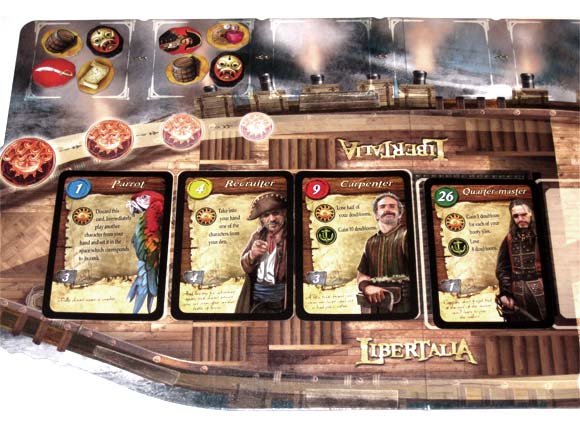
This looting process is repeated until six days are completed. At which point, any pirate characters left in all players’ dens resolve their Campaign effect; represented by an anchor icon. These effects usually involve rewards of doubloons (victory points). The Campaign ends, total doubloons and treasures are counted and marked on the scoring track.
Between campaigns, players have up to three cards left that have not been played and the first player draws 6 news cards, announces them, and players add these cards to their remaining cards in hand. A new campaign begins as the plundering continues.
At this point, the players hands begin to be more varied as some cards have remained un-played in their hands. For the final Campaign, after the final 6 character cards are added players’ remaining hands, the rest of the deck is returned to the box and remain unused until the next game. The player with the most doubloons at the end of three campaigns wins!
Components
The artwork is striking and inspiring. Pirate genre games come with their own specific set of thematic expectations. But the art and graphic work on this game propels you into the world of piratical debauchery. Each character is expertly rendered, and inspires more thematic game play. The components themselves are sturdy and for the most part, functional.
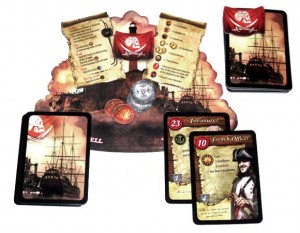
With a more economical layout, the game could be played in less space, but it doesn’t detract from the games enjoyment. In fact, the player cards (called “Pirate Dens”) are extremely functional with player turn actions and Booty Tile values listed on them for quick reference. The rulebook is clear and easy to understand: perfect components for an excellent game.
Learning Curve
Libertalia is very easy to learn and the instructions are well written. Players can easily learn by playing, sacrificing very little strategy while doing so.
Who would enjoy this game?
Final Thoughts
Pirates! Aliens! Ninjas! Zombies! Ugh. It seems like these common game themes have been done and are being redone over and over again. That might be enough to turn some folks off even trying Libertalia, but we encourage you to take a second look. Often times these themes can be lightly pasted onto a set of mediocre mechanics – luring the unsuspecting gamer into a purchase based on the cool artwork and the hype. But this game, by Paulo Mori and Asmodee, offer gamers well integrated mechanics, theme, unique strategy, tactics and interactive card-play that is visually vibrant and well…just plain fun.
Libertalia’s strength is in Mori’s design. With each player beginning the game with the exact same cards, emphasis is on timing and card choice as opposed to player resources and random card draws. The 30 different card effects are well thought out and work well in combination with each other. The resulting card interactions, (and consequently, player interactions) provide an entertaining and compelling journey toward Pirate retirement.
The game also scales well. Two-player games are as fast and deadly like a saber duel, creating a game that promotes anticipating the other’s move and using your hand of cards to counteract their affects and grab the best Booty first. With 4-6 players, the game still plays quickly, but simmers a bit more like an impending tavern brawl. Remembering a played card becomes more difficult and elements of a more long-term strategy begin to emerge. The only truly random feature is the drawing of Booty tiles (one for each player, each day). But some character card effects can cause players to find themselves unable to collect Booty (which isn’t all that bad sometimes) and also to turn Cursed Idols and other detrimental treasure into a doubloon windfall.
There is one aspect of the game that may not sit well with some (especially family gamers), and has to do with some game effects targeting female characters.
The three female characters (Governors Daughter, Waitress and Granny Wata (a mermaid presumably) have effects that trigger while in a player’s den. For some reason, whether by design or coincidence, a situation is created where these female characters’ abilities are the exact cards that players must “kill” (using a Saber Booty Tile) to make sure their effects don’t take place. It just didn’t sit right as a father and someone who enjoys strong female role models. “I guess I have to kill the Governor’s Daughter…” Ok, maybe the pirating era was more barbaric, but its just seems like an unnecessary coincidence. It won’t spoil the enjoyment for most, but it is something to be aware of when choosing this game for specific audiences.
That strange idiosyncrasy aside, the game is one of the best designed on the market. Gameplay is elegant. And once more it bears mentioning that the art design is second to none. Artists Ben Carre and Stéphane Gantiez have created a feast for the eyes, each character perfectly rendered to a degree that they could come to life right off the cards. The art alone inspires and supports the theme, and makes the game that much more enjoyable.
Libertalia offers a great new turn on a Pirate theme, ingenious card play, streamlined game turns and tantalizing art. Even the most sheepish of pirates will want to plunder over and over again.
User Reviews (12)
Add a Review for "Libertalia"
You must be logged in to add a review.


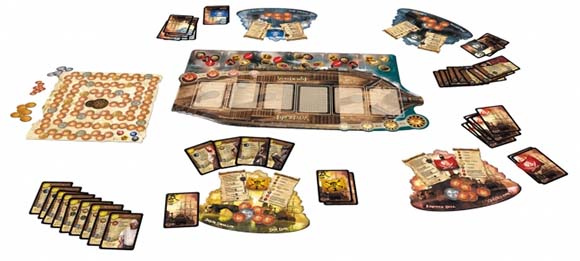

Libertalia allows the internal politics of a pirate crew to play out over three rounds of careful card play. With 30 different crew members, each interacting in different ways, Libertalia looks to find who is best at managing the varying desires and personalities of their cards (errr… crew).
Game Play
Once the game play is understood, the mechanics of Libertalia are quite simple. All players play a card (numbered 1 – 30) from their hand face down. Cards are then placed in ascending order onto the pirate ship. From lowest to highest, take the day action on the card. Then from highest to lowest, take a treasure token. Finally, check your collected characters for night actions, and take any that are appropriate.
This happens for six turns (days) per round, then any end of week (one time scoring) actions occur and points are awarded. After three rounds, the person with the most points wins.
It’s in the card interactions and timing of when you play them that Libertalia starts to shine.
Card Roles
The key to Libertalia, and what makes it stand out from other games are the crew cards. Everyone gets a deck of 30 that are identical (other than tie breaker numbers for different cards). Everyone will start the game with the same cards as everyone else (fight the urge to shuffle!!!).
You start with nine cards, but will play six over the first round. After this, six more cards (the same for each person) are drawn and added to your remaining cards. Since you choose which cards to play each turn, you may have set yourself up with a different hand than your opponents. This continues into the third round, giving opportunities for shrewd play, holding back cards others played quickly, or jumping on an opportunity while others wait in hopes of better combinations.
For those concerned about replayability, don’t worry, while everyone starts with the same nine cards as each other, those nine cards are randomly selected each game.
Pirate Booty
Pirate games need treasure, and Libertalia gives treasure collection its own phase. Your crew’s abilities will be played from lowest value to highest (typically higher numbers have stronger effects), but you collect booty from highest to lowest (assuming your crew survived the day).
There will be one booty tile per player, which you’ll see in advance. Many are good (positive points), while some are cursed (negative points), and others allow you to discard crew, either yours or your neighbors’. There are also maps that are worthless alone, but worth a lot (12 points) if you get three. This treasure collection adds to the strategy of card play. Do you use your high card to try and grab treasure now, or wait until later when it may be more lucrative?
My Thoughts
Libertalia gives everyone the same starting cards each round, and yet still allows people to end up with different hands during different rounds. I find this to be the greatest strength of the game, and where the replayability lies. Once you begin to know what different cards in the deck do, and what cards combine well with others, you can start planning out your strategy of carrying over cards for later, or playing them out this turn. It’s always a great shock to see that card from the first round show up at the end of the game to win the day!
I agree with Ramenhotep that there are more components than are necessary to play the game, but it does lead to a very attractive game that catches the eye of people walking by. They also add a feeling of “weight” to a game that is, at its heart, a card game. I would have preferred the scoreboard be integrated around the central shipboard; the existing scoreboard is a bit hard to read as it spirals inward, but gets the job done.
I’ve played Libertalia with casual, social, and avid gamers, and all have enjoyed it and wanted to play again. As long as the theme is acceptable, family gamers should enjoy the game, while it may leave power and strategy gamers looking for a bit more.
Overall, I would recommend giving Libertalia a try, it keeps the theme of interactions between pirates on a ship, while also giving some interesting decisions along the way!
Overview
Libertalia is a competitive card game of looting and plundering for 2-6 players. The game is played in three “Campaigns” consisting of seven days. The first six days are divided into Sunrise, Day, Dusk, and Night; different character cards, which represent crew members, have special abilities in different parts of the day. Players use these cards for their ordinal value (the “rank” of the crew member) to get first pick of the loot for the day, or their special ability, or both.
There are 30 characters in all; players start with 9, and will use 6 (or 7) during each Campaign, and replenish with a new six between campaigns. The game mechanics are such that the nine starting cards, and each set of replenishments, are the same for all players. However, the play mechanics and some of the powers, combine to create an increasing variety of crew members in each campaign as the game progresses.
The publisher suggests ages 14+, but I think this game can be played by sharper 12 year olds with good result.
My experience is that with 6 players, game duration fall in the 45-60 minute range. You might find some turns take a while, depending on the mix of cards in the hand.
Components
The components for this game are good; the artwork is beautiful, the game board is sturdy and has a very clean design, and the loot tokens are sturdy and easily differentiated from one another. The only ding I can give the game here is that the cards are less robust than I’d like; they seem like they’d be susceptible to both general wear and to corner bending. I recommend sleeves to prolong card life.
Experience
Theme
The pirate theme in this game is carried through to great effect; all 30 of the cards have great artwork, relate well to what the character they portray is supposed to be and do, and interact well with one another. The looting mechanic is fun and flavorful, especially with the two direct action items, the Spanish Officer and the Saber.
Mechanics
This game makes some really interesting modifications on the ordinal mechanic used by a lot of games. Each player has a set of 30 identical character cards for forming his crew; the cards available are limited and identical for all players over the course of the game, but play order and special abilities can provide variance in cards between campaigns. Each crew member card has a rank, which is the ordinal value of the character, ranging from the Parrot to the Captain.
During the “Sunrise” phase, ach player selects the character card they’re going to play for the day. These are turned up, and placed in ascending rank order on the ship; ties are broken by an Influence number on the cards, whose precedence is distributed across the individual player decks for balance.
The “Day” phase proceeds with playing all of the Day special abilities of characters from lowest rank to highest. This is a great mechanic, because some of the abilities enable you to alter character order or interfere with abilities.
During the “Dusk” phase, looting takes place. Beginning with the highest ranking characters, players select a booty token from the day’s hold, and execute any Dusk special abilities. Then, the character card is placed in the player’s “Den.”
Finally, the “Night” phase occurs, where all characters in a player’s den having Night powers my execute them. These powers execute each day, so some of these Night powers can be pretty beneficial.
Interaction
This game surprised me with both the amount and variety of interaction between players. You can jockey for position in the looting order, steal from other players, stick players with cursed booty, and assassinate characters in an opponent’s den. A lot of the interaction is dependent on the cards in the round, and the interaction with other cards, so there’s a lot of variability from game to game in how much you can affect other players.
Difficulty
This is a game that has very simple rules, and can be learned in just a few minutes. At the same time, there’s a lot of complexity and strategy in the card interaction, so players experienced with the game have a distinct advantage over new players.
Complexity of game
There’s a lot of hidden complexity in this game; the interactions between the characters and their abilities carry a lot of nuance that could prove frustrating for new players, particularly younger ones. I think that with some thought, one could come up with an ideal set of cards for a first game as a teaching game, progressively adding complexity in succeeding campaigns so that new players won’t be overwhelmed.
Clarity of rules
The rules are brief and concise; no confusing language, but there are a couple of places where I would have grouped information differently.
Replay Potential
Completeness as base game
It’s my opinion that you could play this game indefinitely without it feeling repetitive. With 30 characters, the number of possible combinations coming in sets of 9/6/6 are plentiful, and there are so many options that I don’t see it getting stale.
Expansions
There aren’t any expansions for this game yet, but there’s definitely room for an expansion set of replacement characters (say 8 characters that swap in for ones in the base deck), and even new booty tokens.
Summary
Pros
Replayability, outstanding mechanics, and a very workable duration all line up in this game’s favor. Great artwork and exceptional integration of the pirate theme throughout the mechanics provide great flavor.
Cons
The sheer number of options can cause some players to lock up; this could be solved by placing the Sunrise phase on a timer. I’m also uncertain of the long-term playability of the cards if not sleeved.
Conclusions
I was concerned that this would turn into some awkward hybrid of Citadels and Aladdin’s Dragons, but though there are several games out there with an ordering mechanic based on card choices, and a few with a collecting scheme, positively everything about this was fresh. The pirate theme was actually integrated into the feel of the play, rather than just being an artistic theme brushed over an abstract game.
I expect Libertalia to be a staple of our gaming group for a long time.
Well, well, well! Libertalia was our very first non-mainstream board game purchase, and we couldn’t be happier with our choice. Even opening the lovely box is a joy. The pirate theme is fantastic, not to mention beautifully illustrated, and gives great context to this cleverly designed and wily game.
Making sure every player starts the first round with the same cards is brilliant; three rounds in, everyone loses track of who’s played what, but strategy is still possible. There’s some superb balancing going on and plenty of player interaction.
The card stock feels so very classy and the incredible artwork is something to be marvelled over – the characters seem almost alive. It’s a relatively simple game to learn (although you might need some clarification of some rules or situations from online sources) and the pleasingly designed manual is as simple as it needs to be.
The game scales well between 2 and 6 players, really coming alive with three or more, but we play it often just the two of us and it gets rather heated, in a very good way.
We can’t recommend this game highly enough, it is a very classy proposition.
This game is a blast.
It’s dead simple to pick up and the goal is just that of pirates.
Amass loot!
Everyone has the same pool of assets for the most part so it’s up to you to play them accordingly.
System is based on numbers, first to play, last to collect and vice verse.
I could see hardcore people maybe putting their nose in the air on this one, but make them play it while your waiting for the rest of the group to finish their stops for Burger King or something!
—————————————————————
Pro’s –
Tons of fun!
Easy to learn.
Quick to play.
No real gotchas in the gameplay at all!
—————————————————————
Con’s –
Can’t think of anything significant.
————————————————————-
Overall, this game is tons of fun. It’s fast, easy, fun. I would recommend any gamer keeping this in their rotation.
Libertalia is a great lightish pirate game that is easy to learn and easy to play, yet has a decent amount of strategy.
In Libertalia you play three “campaigns” each consisting of six rounds. In each round you choose one of 9 cards in your hand. Note: each player has 30 cards and each player’s deck of 30 is the same as the other players. For the first campaign 9 cards are chosen randomly. In the two subsequent campaigns 6 cards are added to get players back up to 9.
All players will simultaneously choose a card and place it face down on the board. Then once they are flipped over they will be placed in numerical order (there is a tiebreaker in gray on the cards in case two players chose the same numbered card). Then in order they will be activated, first in a “day” phase, then in a “dusk” phase. Cards will have certain actions that can only be activated in certain phases. After the dusk phase players will also grab a booty token. These tokens can be worth positive or negative points, or they can allow you to remove a neighbor’s card. After the dusk phase the cards are moved from the board to right in front of you. Then the “night” phase gets activated.
Through all the phases players are trying to obtain doubloons. The player with the most doubloons will win. Doubloons are scored at the end of each campaign, after which players will start the next campaign with 10 doubloons, just like the start of the game.
There is a lot of interaction in the game and there is a lot of suspense. I was constantly hoping no one would use a saber booty token to get rid of one of my cards. And I was also trying to make sure I played cards that I thought would work well with what I predicted other players would play. It was a great mental battle. The artwork is great and the game plays quickly, even with up to 6 players. I recommend it!
I am not a fan of this game in the slightest so take my review for what it is. To me this game is a mechanism and that’s about it. The mechanism is solid, selecting characters from a set group that everyone has and then deciding when to play which one. The problem is, that’s it. Unlike Glass Road (similar mechanism) there isn’t any other real decision to be made past that which I would love to see. It’s not a horrible game, I just want more.
Hey guys,
We are ‘The Misery Farm’- 3 Ladies, an assortment of generic gaming buddies, and a*uva lot of games. Here you’ll find humourous, sarcastic, or just plain drunk reviews of board games and board game-related stuff.
We’ve just reviewed Libertalia here – http://themiseryfarm.com/2015/05/24/libertalia-how-to-pirate-101/
We thought the game was fun, fast paced, and yet we still made amusing mistakes throughout. We recommend playing with a large group of friends at least once. We’d love any comments or feedback.
Thanks,
The Misery Farm
I very much enjoyed the gameplay and mechanics of this game. The cards had cool mechanics and interactions, and I will totally play this with my gamer friends! That said, this game has a few strange flaws outside of gameplay:
Unnecessary components — Each player gets a chipboard flag, which serves no purpose. Each player gets an identity board, which serves no purpose other than to remind you of turn order and treasure value. There is a center board, which serves no purpose other than making layout easier. Finally, the point tracking board isn’t strictly necessary. The components are pretty, though, so I’m okay with the fact that this could basically just be a card game.
Too many zones! — There are way too many zones during gameplay, which makes this game difficult to teach to non-gamers. Aside from the in play zones (your hand and on the board), each player must have 4 stacks of cards: the deck from which you draw between rounds, your “den” of pirates played this round, your “discard” of pirates that died this round, and a removed from game pile of pirates used in previous rounds. I would be willing to forgive this if they had simply used some of the unnecessary board space to codify where to put these piles, but they don’t.
Terrible representation of women — There are 30 different characters in this game. 2 are animals, 3 are women, and 25 are men. Of the three women (according to their flavor texts), one has been kidnapped for ***, one exists only to be ogled, and one is a mystical shaman. What’s wrong with having women pirates? This game misses a great opportunity for cool female characters.
One of the biggest points of excitement about Libertalia is the theme: pirates. But it is not the first pirate themed game to exist (there are probably more than 150 including at least one collectable card game and one miniatures game). The question is, “How does Libertalia stack up against these other pirate games?”
Here are my top ten pirate games:
1. Merchants & Marauders (2010) – a 3+hour massive game where players choose to make a fortune through trade, treasure hunting or stealing others treasures. Great for avid, strategy or power gamers.
2. Libertalia(2012) – a very innovative simultaneous role selection game that involves direct conflict and plays in about 45 to 60 minutes. The card role interaction will remind some players of Citadels but on a much grander scale. Great for casual, avid, or strategy gamers.
3. Jamaica (2007) – a game of racing pirates who collect treasure along the way that plays in 45 minutes. This game uses dice and simultaneous action selection. Great for family, casual, or avid gamers.
4. Broadsides and Boarding Parties (1982) – a classic light, tactical game for two, where you command a pirate ships try to sink each other. This game could be #1 on either physical size (the pirate ships are a foot tall) or on nostalgia (old MB Gamemaster Series). Gameplay lasts about an hour. Great for family, casual, or avid gamers.
5. Cartagena (2000) – a game of pirates escaping from imprisonment in the fortress of Cartagena. Each player control six pirates that they try to lead to freedom. The game plays in about 45 minutes. Great for avid, strategy or power gamers.
6. Rum & Pirates (2006) – a Stefan Feld game where pirates compete for honor and the best sleeping quarters on the ship. This is probably one of Feld’s lightest games (in terms of game weight or depth) and plays in about an hour. Great for family, casual, or avid gamers.
7. Der Schwarze Pirat (aka: The Black Pirate- 2006) – the best pirate game for children under the age of 8 (Loot would be the second best). Each player commands a sailing ship (with a real sail) that actually is propelled by a bellow. You blow the ships around the game board to collect treasures, while avoiding the dreaded black pirate. Great for family and social gamers.
8. Pirates of Nassau (2012) – new “euro-type” pirate game with lots of choices and scoring options. Needs more exposure to move up (I have read about but not played). Lighter in weight, scope and length than Merchants & Marauders. Play time is around 2 hours. Great for avid, strategy or power gamers.
9. Blackbeard (2008) -a remake of Richard Berg’s 1991 Avalon Hill hex and counter game by the same title that changed to card driven battle system mechanic in the newer version. This is really a war game with a pirate theme. Great for war, strategy, or power gamers.
10. Pirate’s Cove (2002) – another simultaneous action selection game that involves hand management, as players try to capture treasure from six different islands. If one or more players end up on the same island, their ships battle using dice to decide who gets the treasure. A lighter pirate game that takes 90 minutes. Great for family, casual, and avid gamers.
Libertalia is great game with a fun theme. While it is new, I believe it does have “legs” and be a game that I am still playing 3 or 4 years from now. You may not need all ten of these pirate games but you should consider at least owning a couple (I own five of them – #s 1, 2, 4, 5 & 7). Pirates (in fiction) = more fun.
My Thoughts
Libertalia is a competitive pirate card/board game based on some role selection. It’s a pretty easy game to learn and play. The theme is enjoyable but still lacks that something special to make you feel like you’re actually a pirate trying to plunder gold.
My Story
I purchased this game on coolstuff for $33 and added it to my cart for two main reasons. The first was I need to add a game around $33 in order to get free shipping 😛 the other reason was because I really wanted a pirate game to play. Now that I’ve played it a half a dozen times I’ve found that although nobody is blown out of the water by the game they enjoy it and find it super easy to learn. I also went a head a upgraded some components to give a little bit of a pirate touch but I’ll get into that under components.
Components
Most of the components are of pretty good quality but there is an excess of them it seems. It’s almost like they added some extra things but they didn’t really contribute to the game all that much. The art on the cards looks great. The cardboard is nice and thick but that being said I went onto EBay and found some metal pirate coins to replace the cardboard ones provided. I find they help you to connect just a little bit more.
1 game board
6 pirate dens
6 score tokens
6 crew tokens
180 character cards (30 for each player)
1 score track
50 booty tiles [4 chests, 6 jewelry, 10 goods, 6 Spanish Officers, 6 sabers, 8 treasure maps, 10 cursed relics]
13 doubloons of value 10
10 doubloons of value 5
45 doubloons of value 1
rules.
Setup
The board has treasure randomly pulled from a bag and added for each day the number depending on the number of players. Each person then gets a deck of 30 cards with pirates of various rank on them. The first person shuffles their deck and draws 9 pirates, then all the other pirates have to take the same pirates out of their deck so everyone has the same nine pirates. The rest of the decks are put aside for later. Every player gets 10 doubloons and the rest are put into a supply pile. You are now ready to play.
Game play
The game is broken up into 3 campaigns of 6 days each. Each day everyone plays a pirate face down so nobody else knows what they played. Once everyone has played their pirate they are all flipped over and put onto the board (ship in order of their rank. Then each day the pirates selected have to divvy up their loot for the day and the highest ranking pirate chooses first so it comes done to know when to play your pirate in order to rank the others. However each pirate also has a special ability which changes every turn up just a little bit that may stop someone fro getting their treasure, or killing of someone else. Once you’ve gone through the 6 days you tally up your doubloons and move your tracker on the scoreboard. Each player then returns all their treasure and takes 10 doubloons for the next round. Each player should also have 3 pirates left over in their hand. The first player will draw six more pirates from the deck and add it to his hand making sure everyone else does the same. So this time round everyone has 6 identical cards and the 3 left over from before. Play continues this way until the end of the 3rd campaign and the person with the most points wins.
Conclusion
This is a simple competitive game that I can bring out and play with just about anyone as it’s really easy to teach. The pirate theme is always easy to convince people to play, so it’s not hard to find people to enjoy it with. The arrrs will be in full swing before you know it.
All in all this game is fun, and worth trying out. I’m still looking for a pirate game that has that something special. I’ve been wanting to try Merchants and Marauders but it’s out of stock everywhere, and I backed Privateer on Kickstarter but it is on hold until further notice.
If I find the game I’m looking for I’ll come back and edit this to let you all know 😛
The interaction between players is fun and cut throat and the game scales well with different numbers of players. The character cards play well off each other and their varying effects lead to interesting confrontations between the pirates. The art is beautiful and the components are sturdy and well-made. After you play this game once – you’ll probably want to set it up to play another game immediately after.
According to box, two people can play. Yes. That being said, the game moves way too quickly with just two players and a lot of the pirate intrigue (stealing/killing) leaves little to imagination (you will be stealing/killing the other player). I would play again, but only if I have more than two people.
The rules are fairly straight-forward, but as with many games which have characters with special abilities, you will have to figure it out the best you can. The instructions do not give any clarifications on the characters’ special abilities. It isn’t that big of a deal, but it would have been nice to have a wiki or website (like Loony Labs does).